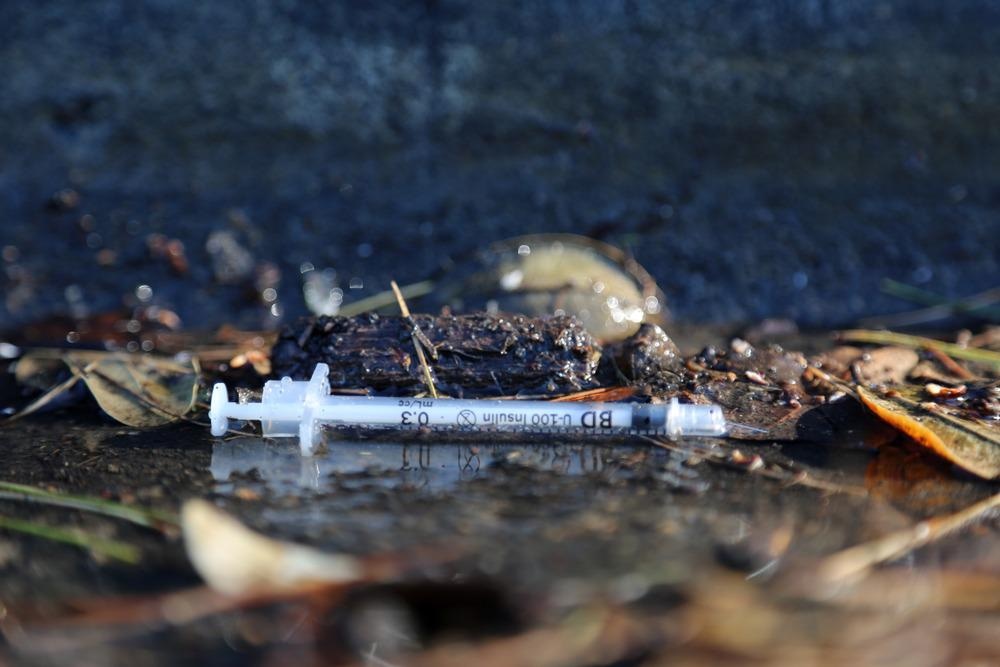What are synthetic street drugs?
Synthetic street drugs are those that are developed to mimic the effects of illicit drugs already on the market, such as cannabis, cocaine, ecstasy, and heroin. These synthetic substances are known as ‘new psychoactive substances’ (NSPs). Because they are new substances, they are not initially controlled by the United Nations international drug laws.
Benzodiazepines (and other sedative-hypnotics), cannabinoids, hallucinogens and dissociatives, opioids, phenethylamines, piperazines, synthetic cathinones, and tryptamines are examples of types of NSPs that are currently emerging on the market. The number of NSPs being created seems to be increasing. In Europe alone, 400 NSPs are identified annually.

Image Credit: mikeledray/Shutterstock.com
The impact of newly emerging synthetic street drugs
New synthetic street drugs pose a significant level of threat to the communities and people they impact. Overall, NSPs are dangerous, they are unregulated and they are often more potent than the illicit substance they intend to mimic. People using NSPs have little experience of how to use the drug or how it will affect them because the substance is new, and while it imitates other drugs, it is different.
Additionally, law enforcement and healthcare services are often unprepared to respond when the use of new synthetic drugs begins to become an issue. Again, because they are new, it is hard to predict patterns of use and what the implications will be. The emergence of new NSPs threatens to increase the rates of accidental overdoses.
Synthetic drugs are often cheaper to produce and more potent than the illicit drugs they mimic, for this reason, they are often mixed in with other drugs without users’ knowledge, causing them to take more than they intended to. Also, interactions of NSPs with other drugs such as alcohol, prescription, and over-the-counter medicines are generally poorly understood due to their novelty.
Media reports indicate that many people have died or experienced adverse effects from taking new synthetic street drugs. A 2017 study revealed that in Europe, one-in-six drug-related deaths were attributed to NSPs, representing an increase from 2016.
It is of great concern that experts believe that the use of NSPs is on the rise, particularly following the outbreak of Covid-19. Data collected by the Centers for Disease Control and Prevention reveal that as of June 2020, 13% of Americans had increased their substance use as a way of mitigating the stress or emotions caused by the pandemic. Additionally, the pandemic has impacted the availability of illicit drugs, it is theorized that this may have led to increased use of more readily available new synthetic street drugs.
Given the risks to human health and communities posed by new synthetic street drugs, it is important that we have processes that can rapidly and effectively detect them.
Developing effective new detection methods with Raman spectrometry
Previously, US law enforcement officers who discovered suspected drugs generally used “wet chem kits” to conduct field testing to identify the substance. These kits usually require officers to obtain a small sample of the substance with a spatula and to add it to an envelope which is then sealed. Next, the ampules and squeezed and popped open in their designated order, and the sample is mixed with the various reagents. These reagents change color in the presence of different drugs, and each class of drugs requires a separate kit.
If the first kit returns a negative result, the officer must continue testing the substance with the different kits. These conventional test kits are subject to human error and misinterpretation, plus, the act of taking the sample puts law enforcement officers at risk of exposure.
To overcome these limitations, scientists have developed handheld Raman spectrometers, which were initially created to help hazmat teams and bomb squads identify explosives, to identify drugs instead. A laser is used to scatter light from the molecules in the sample, the spectra produced by this scattering can be matched to known spectra produced by various illicit drugs, synthetic drugs, drug precursors, and cutting agents.
Two examples of handheld Raman spectrometers that have already been adopted by law enforcement agencies for portable drug testing are the Thermo Fisher Scientific TruNarc, launched in 2021, and the TacticID B&W Tek, which was introduced in 2014. All that is required from these new devices is the pushing of a few buttons before a non-biased and reliable result is displayed.
These devices can scan a variety of unknown substances, including both pills and powders. The instruments store the data produced from each test and cannot be deleted, which helps to reduce user error or attempts to tamper with the device. This information can be transferred to a computer which helps to streamline the records process and enables law enforcement agencies to quickly share information with other agencies and organizations to help experts build a bigger picture of the spread and use of new synthetic street drugs.
The only drawback of these devices is their hefty price tag, making them inaccessible for some law enforcement agencies. It is hoped that as the cost of technology continues to fall and advances are made, these devices will become more widely available.
Sources:
- (2017). Emma Hiolski. Powerful detection technology for powerful new street drugs. [Online]. Chemical & Engineering News. Available at: cen.acs.org/.../Powerful-detection-technology-powerful-new.html (Accessed 27 October 2021)
- López-Pelayo, H. et al., 2021. Mortality involving new psychoactive substances across Europe, 2016-2017. Emerging Trends in Drugs, Addictions, and Health, 1, p.100016. https://www.sciencedirect.com/science/article/pii/S2667118221000143
- Zaami, S., Marinelli, E. & Varì, M.R., 2020. New trends of substance abuse during COVID-19 pandemic: An international perspective. Frontiers in Psychiatry, 11. https://www.frontiersin.org/articles/10.3389/fpsyt.2020.00700/full
Further Reading
Last Updated: Jan 27, 2022